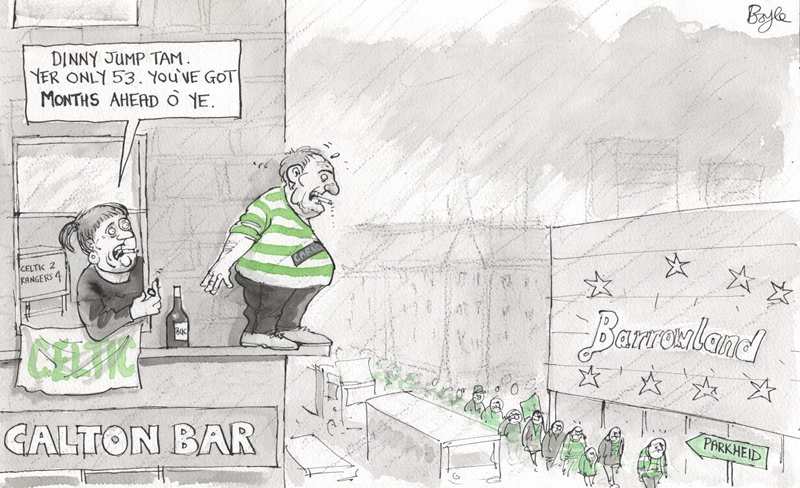The Old Family
and how we got here
William Gray married Elizabeth Smith. You can't get much more common names than that in Scotland but despite that we still have managed to identify them clearly in the records. William, who almost certainly would have been Wull or Billy or some other variation, was born in Calton, which is in the East End of Glasgow. It was part of the parish of Barony where William's parents, weaver James Gray and Jane Begg, married in 1805. There is an interesting article on a strike by the weavers of Calton (paragraphs 7 and 8) in which the Riot Act was read and three weavers shot by the military (though nobody by the name of Gray or Begg). The same article describes the inhabitants of Calton as being "lawless and unruly" at the start of the 1800s. Not the place to be then. Nowadays Celtic Park is in the middle of the area so not much has changed.

Cartoon published after Celtic lost to Rangers and life expectancy announced as 54 in Calton, the lowest in the country.
However, the Commonwealth Games of 2014 was centred there so an attempt is being made to regenerate the area. The old Calton was mainly the area between Glasgow Green and the Gallowgate, possibly the most run-down part of the city after the Gorbals was redeveloped. The article above has some wonderful quotes such as "in order to prevent Irish and other disorderly persons from going about," or "Mrs. Peebles, an old wretch, residing in Main Street, Calton, for having her house in a disorderly state on Sunday morning., was fined in two shillings and sixpence."
It's unclear when William left the area and whether the whole family moved or whether it was just him on his own but he married Eliza in Mid Calder in 1835. In later censuses he was a miller and there is a West Mill and an East Mill in old maps of the town so it's an easy guess that he would have been based in one of them.
From there he moved to Scotston or Binns Mill then Houston Mill at Uphall before settling at Philpstoun Mill. It seems likely that he stayed in the big house itself rather than one of the nearby cottages as it had 3 rooms, which is just as well as he had eleven children who all seemed to have survived although it has to be said that the older ones were out supporting themselves before the youngest were around. Once there was enough space he and Eliza started taking in grandchildren, including young James Paterson, and even Eliza's widowed mother. They also surrounded themselves with family in the next door cottages.
Interestingly, on his death record his father was a clerk. Either this is a mistake or his father made a welcome step up from the dying trade of weaving. I have no doubt that the James Gray and Jane Begg found in Barony are his parents. I have less confidence on the reporting of his father as a clerk, given that this information would have been given years after the old man's death.